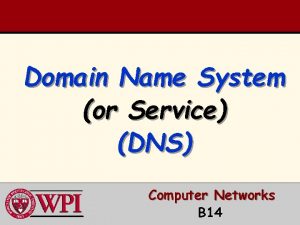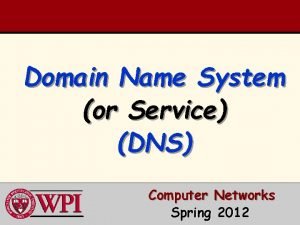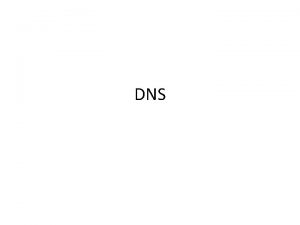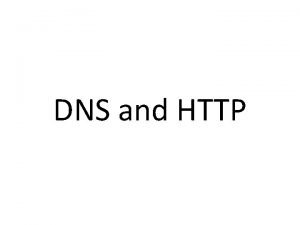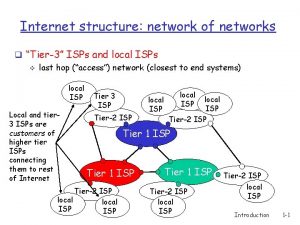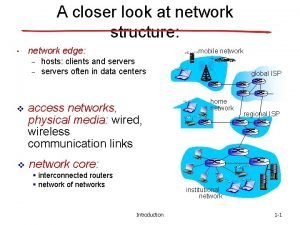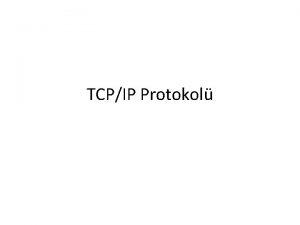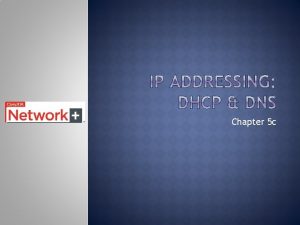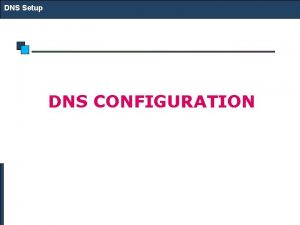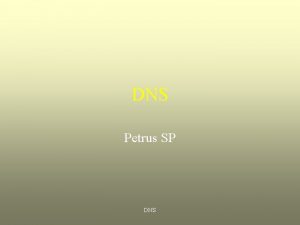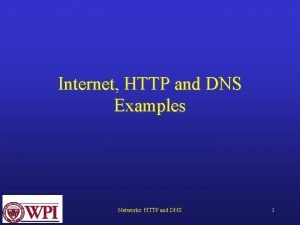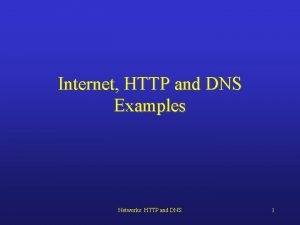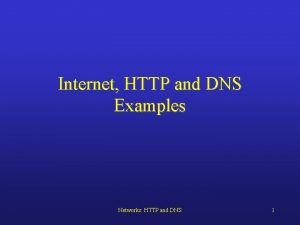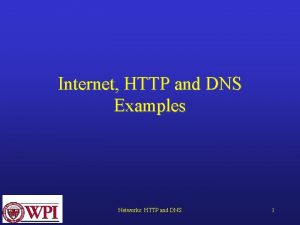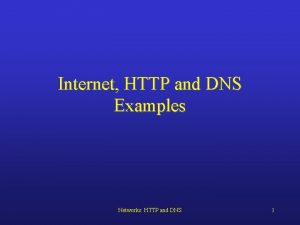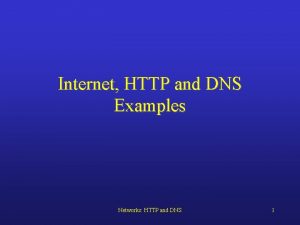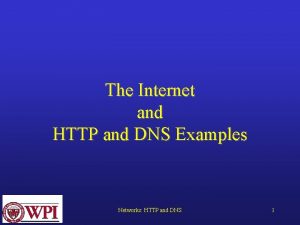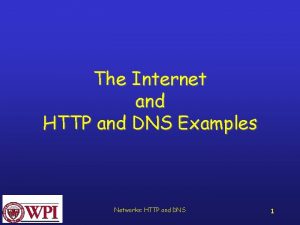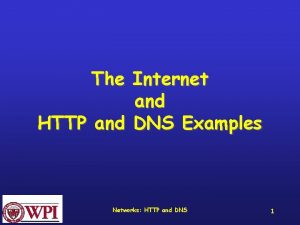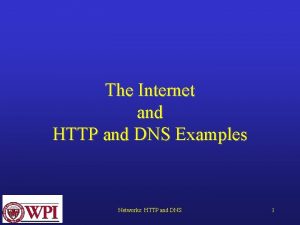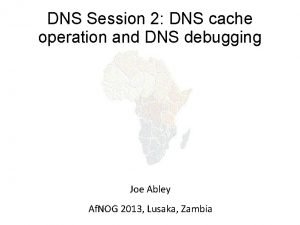Internet HTTP and DNS Examples Networks HTTP and

![The Internet and an internet [LG&W pp. 26 -28] internet : : involves the The Internet and an internet [LG&W pp. 26 -28] internet : : involves the](https://slidetodoc.com/presentation_image_h2/1a4968e2dcf408805343734799c03073/image-2.jpg)




![Applications and Layered Architectures [LG&W pp. 43 -49] • In the 1970’s vendor companies Applications and Layered Architectures [LG&W pp. 43 -49] • In the 1970’s vendor companies](https://slidetodoc.com/presentation_image_h2/1a4968e2dcf408805343734799c03073/image-7.jpg)









- Slides: 16

Internet, HTTP and DNS Examples Networks: HTTP and DNS 1
![The Internet and an internet LGW pp 26 28 internet involves the The Internet and an internet [LG&W pp. 26 -28] internet : : involves the](https://slidetodoc.com/presentation_image_h2/1a4968e2dcf408805343734799c03073/image-2.jpg)
The Internet and an internet [LG&W pp. 26 -28] internet : : involves the interconnection of multiple networks into a single large networks. the “Internet” : : refers to the successor to ARPANET. IP (the Internet Protocol) : : provides connectionless transfer of packets across an internet. Networks: HTTP and DNS 2

An internet G net 1 net 3 G G G net 2 net 5 G net 4 G G = gateway Copyright © 2000 The Mc. Graw Hill Companies Leon-Garcia & Widjaja: Communication Networks: HTTP and DNS Figure 1. 18 3

IP • Currently provides best-effort service – packets may be lost (i. e. , IP is unreliable). • General design philosophy – Keep internal operations simple by relegating complex functions to the edge of the subnet. – IP can operate over any network – allow IP to scale!!! – The end-to-end mechanisms are responsible for recovery of packet losses and congestion control. Networks: HTTP and DNS 4

IP • Uses hierarchical address space with location information embedded in the structure. Network ID Host ID 4 bytes • IP address is usually expressed in dotteddecimal notation (e. g. , 128. 100. 11. 56). Networks: HTTP and DNS 5

Internet • Provides a name space to refer to machines connected to the Internet (e. g. chablis. cs. wpi. edu). • The name space is hierarchical, but is only administrative and not used in network routing operations. • DNS (Domain Name Service) provides automatic translation of names to addresses. Networks: HTTP and DNS 6
![Applications and Layered Architectures LGW pp 43 49 In the 1970s vendor companies Applications and Layered Architectures [LG&W pp. 43 -49] • In the 1970’s vendor companies](https://slidetodoc.com/presentation_image_h2/1a4968e2dcf408805343734799c03073/image-7.jpg)
Applications and Layered Architectures [LG&W pp. 43 -49] • In the 1970’s vendor companies (IBM and DEC) developed proprietary networks with the common feature of grouping communication functions into related and manageable sets called layers. network architecture : : a set of protocols that specify how every layer is to function. Networks: HTTP and DNS 7

TCP/IP Protocol Architecture Model DCC 6 th Ed. , W. Stallings Figure 1. 9 Networks: HTTP and DNS 8

Layering Advantages • Simplified the design process. • Led to flexibility in modifying and developing the network. • Accommodates incremental changes more readily. Networks: HTTP and DNS 9

Layering Examples Client/server relationship : : – Server process waits for incoming requests by listening to a port. – Client process makes requests as required. – Server process provides responses to these requests. – The server process usually runs in the background as a daemon (e. g. httpd is the server daemon for HTTP). Networks: HTTP and DNS 10

HTTP Example • HTTP (Hyper. Text Transfer Protocol) specifies rules by which the client and the server interact so as to retrieve a document. • The protocol assumes the client and the server can exchange messages directly • The client software needs to set up a twoway connection prior to the HTTP request. Networks: HTTP and DNS 11

HTTP client/server interaction Request HTTP client Copyright © 2000 The Mc. Graw Hill Companies HTTP server Response Leon-Garcia & Widjaja: Communication Networks: HTTP and DNS Figure 2. 1 12

SMTP HTTP RTP DNS TCP UDP IP Network Interface 1 Interface 2 Interface 3 Copyright © 2000 The Mc. Graw Hill Companies Leon-Garcia & Widjaja: Communication Networks: HTTP and DNS Figure 2. 12 13

The user clicks on a link to indicate which document is to be retrieved. 1. The browser must determine the address that contains the document. It does this by sending a query to its local name server. 2. Once the address is known the browser establishes a connection to the specified machine, usually a TCP connection. In order for the connection to be successful, the specified machine must be ready to accept TCP connections. 3. 4. The browser runs a client version of HTTP, which issues a request specifying both the name of the document and the possible document formats it can handle. The machine that contains the requested document runs a server version of HTTP. It reacts to the HTTP request by sending an HTTP response which contains the desired document in the appropriate format. 5. 6. The TCP connection is then closed and the user may view the document. Retrieving a Web Page Copyright © 2000 The Mc. Graw Hill Companies Leon-Garcia & Widjaja: Communication Networks Figure 1. 4


Copyright © 2000 The Mc. Graw Hill Companies Leon-Garcia & Widjaja: Communication Networks Figure 2. 2 HTTP server HTTP client Ephemeral Port 80 Port # GET 80, # TCP #, 80 STATUS Networks: HTTP and DNS 16
 Intro dns
Intro dns Dns in computer networks
Dns in computer networks Dns in computer networks
Dns in computer networks A switched wan is normally implemented as a network
A switched wan is normally implemented as a network Canonical name in dns
Canonical name in dns Backbone networks in computer networks
Backbone networks in computer networks Http dns
Http dns Computer networks and internets with internet applications
Computer networks and internets with internet applications Internet transport protocol in computer networks
Internet transport protocol in computer networks Tier 3 isps
Tier 3 isps Internet structure network of networks
Internet structure network of networks Which type of address is this: a3:34:45:11:92:f1
Which type of address is this: a3:34:45:11:92:f1 Osi vs tcp/ip
Osi vs tcp/ip Web and http in computer networks
Web and http in computer networks Internet or internet
Internet or internet Lab 3-5: install and configure dhcp and dns servers
Lab 3-5: install and configure dhcp and dns servers Http //www.meb.gov.tr lgs tercih
Http //www.meb.gov.tr lgs tercih

